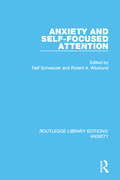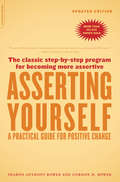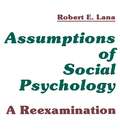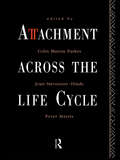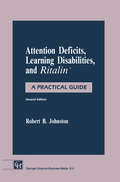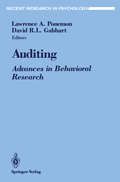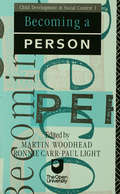- Table View
- List View
Alzheimer's Day Care: A Basic Guide (Series in Death, Dying, and Bereavement)
by David A. Linderman Nancy H. Corby Rachel Downing Beverly SanbornA book whose purpose is to offer guidance to individuals, organizations and agencies on how to develop day care programmes for patients with Alzheimer's disease or a related dementia. A range of programme aspects are covered from administrative details to social factors and evaluation techniques.
Analysing Organizational Behaviour
This is an introductory textbook on organisational behaviour which will be important reading for students studying organisational psychology and managers interested in the behavioural aspects of their work. The book takes a systematic, analytical approach starting from analysing jobs and selecting people to fit the jobs. It also covers the topics of training, motivation, leadership, working in groups, communication, stress and dealing with organisational change and concludes on a personal note concerned with managing your own career.
Analytical Psychology: Notes of the Seminar Given in 1925
by C. G. Jung William McguireFor C. G. Jung, 1925 was a watershed year. He turned fifty, visited the Pueblo Indians of New Mexico and the tribesmen of East Africa, published his first book on the principles of analytical psychology meant for the lay public, and gave the first of his formal seminars in English. The seminar, conducted in weekly meetings during the spring and summer, began with a notably personal account of the development of his thinking from 1896 up to his break with Freud in 1912. It moved on to discussions of the basic tenets of analytical psychology--the collective unconscious, typology, the archetypes, and the anima/animus theory. In the elucidation of that theory, Jung analyzed in detail the symbolism in Rider Haggard's She and other novels. Besides these literary paradigms, he made use of case material, examples in the fine arts, and diagrams.
Analytical Psychology: Notes of the Seminar Given in 1925
by C. G. Jung William McguireFor C. G. Jung, 1925 was a watershed year. He turned fifty, visited the Pueblo Indians of New Mexico and the tribesmen of East Africa, published his first book on the principles of analytical psychology meant for the lay public, and gave the first of his formal seminars in English. The seminar, conducted in weekly meetings during the spring and summer, began with a notably personal account of the development of his thinking from 1896 up to his break with Freud in 1912. It moved on to discussions of the basic tenets of analytical psychology--the collective unconscious, typology, the archetypes, and the anima/animus theory. In the elucidation of that theory, Jung analyzed in detail the symbolism in Rider Haggard's She and other novels. Besides these literary paradigms, he made use of case material, examples in the fine arts, and diagrams.
Annals of Theoretical Psychology (Annals of Theoretical Psychology #7)
by Paul Van Geert Leendert P. MosThis is the first of a two-volume work in the Annals series devoted to developmental psychology. The project was originally conceived in 1985 when Paul van Geert, who had just completed his Theory building in developmental psychology (North Holland, 1986), agreed to col laborate on anAnnals volume examining foundational issues pertaining to the concept of development. The project attracted considerable interest and, in view of the length of the resulting manuscript, a decision was made to publish it in two volumes. Fortunately, the contributors provided coherent perspectives on two relatively distinct developmen tal themes which served to facilitate our task of dividing their contribu tions into two volumes. The first volume deals with the foundations of developmental theory and methodology; the second volume -to appear as Volume 8 of the Annals -with theoretical issues in developmental psychology. In this first volume, the contributions by Willis Overton and Joachim Wohlwill were completed in 1988, those by Roger Dixon, Richard Lerner, and David Hultsch, and Paul van Geert in 1989. Commentaries followed quickly and replies to commentaries were completed in 1990. Paul van Geert provides a general framework within which the founda tional issues of development are discussed. He is especially concerned with the nature of transition models and the structure of time in developmental theory. The relationship between methods and framework, or theory, is the topic of Joachim Wohlwill's contribution.
The Annual of Psychoanalysis, V. 19
by Jerome A. WinerVolume 19 of The Annual of Psychoanalysis turns to the ever-intriguing relationship between "Psychoanalysis and Art." This introductory section begins with Donald Kuspit's scholarly reflections on the role of analysis in visual art and art criticism, and then proceeds to a series of topical studies on Freud and art introduced by Harry Trosman. Egyptologist Lorelei Corcoran explores the Egypt of Freud's imagination, thereby illuminating our understanding of the archaeological metaphor. Marion Tolpin offers new insights into Freud's analysis of the American writer Hilda Doolittle by focusing on the meaning of the Goddess Athene - whose statue rested on Freud's desk - to both analyst and analysand. Stephen Toulmin examines Freud's artistic sensibility - and places the historical significance of Freud's art collection in bold relief - by looking at the many contemporary art objects Freud chose not to collect. Danielle Knafo identifies key events in the early life of Austrian Expressionist Egon Schiele that were "primary determinants" of the content and form of his self-portraits. And Barbara Almond examines the spontaneous healing process depicted in Margaret Drabble's novel The Needle's Eye as an analogue to the kind of growth and development mobilized by the psychoanalytic process. Section II, "Psychoanalysis and Development," begins with Barbara Fajardo's appreciation of the contribution of biology to analyzability; she reviews findings from both infant research and biogenetic research that tend toward an understanding of "constitution" as resilience in development and, subsequently, in treatment. Benjamin Garber adds to the psychoanalytic understanding of childhood learning disabilities by presenting the three-and-a-half-year analysis of a learning-disabled child. In a fascinating two-part contribution, "Bridging the Chasm Between Developmental Theory and Clinical Theory," Joseph Palombo sheds light on some of the knottiest problems in contemporary analysis, including the relationship between childhood events and the reconstruction of those events in treatment. In Section III, "Psychoanalysis and Empathy," Mary Newsome presents case material in support of her claim that the analyst's empathic understanding catalyzes the coalescence of the patient's affect and aim, that is, the patient's capacity to believe in and then realize his ambitions. The acquisition of the capacity, she contends, not only betokens a specific kind of structure formation, but is the bedrock of emerging self-cohesion. Her challenging paper is thoughtfully discussed by David Terman and Jerome Winer. Section IV of The Annual offers Jerome Kavka's appreciation of the work of N. Lionel Blitzsten (1893-1952). Blitzsten, the first Chicago psychoanalyst and one of America's most gifted clinicians and teachers, anticipated modern concepts of narcissism in identifying "narcissistic neuroses" with special treatment requirements. Morris Sklansky furthers our understanding of Blitzsten in his discussion of Kavka's essay. Ranging across the analytic canvas with presentations as edifying as they are provocative, volume 19 of The Annual of Psychoanalysis challenges readers to wrestle with issues at the cutting edge of the discipline. It takes a well-deserved place in the preeminent continuing series in the field.
The Annual of Psychoanalysis, V. 19
by Jerome A. WinerVolume 19 of The Annual of Psychoanalysis turns to the ever-intriguing relationship between "Psychoanalysis and Art." This introductory section begins with Donald Kuspit's scholarly reflections on the role of analysis in visual art and art criticism, and then proceeds to a series of topical studies on Freud and art introduced by Harry Trosman. Egyptologist Lorelei Corcoran explores the Egypt of Freud's imagination, thereby illuminating our understanding of the archaeological metaphor. Marion Tolpin offers new insights into Freud's analysis of the American writer Hilda Doolittle by focusing on the meaning of the Goddess Athene - whose statue rested on Freud's desk - to both analyst and analysand. Stephen Toulmin examines Freud's artistic sensibility - and places the historical significance of Freud's art collection in bold relief - by looking at the many contemporary art objects Freud chose not to collect. Danielle Knafo identifies key events in the early life of Austrian Expressionist Egon Schiele that were "primary determinants" of the content and form of his self-portraits. And Barbara Almond examines the spontaneous healing process depicted in Margaret Drabble's novel The Needle's Eye as an analogue to the kind of growth and development mobilized by the psychoanalytic process. Section II, "Psychoanalysis and Development," begins with Barbara Fajardo's appreciation of the contribution of biology to analyzability; she reviews findings from both infant research and biogenetic research that tend toward an understanding of "constitution" as resilience in development and, subsequently, in treatment. Benjamin Garber adds to the psychoanalytic understanding of childhood learning disabilities by presenting the three-and-a-half-year analysis of a learning-disabled child. In a fascinating two-part contribution, "Bridging the Chasm Between Developmental Theory and Clinical Theory," Joseph Palombo sheds light on some of the knottiest problems in contemporary analysis, including the relationship between childhood events and the reconstruction of those events in treatment. In Section III, "Psychoanalysis and Empathy," Mary Newsome presents case material in support of her claim that the analyst's empathic understanding catalyzes the coalescence of the patient's affect and aim, that is, the patient's capacity to believe in and then realize his ambitions. The acquisition of the capacity, she contends, not only betokens a specific kind of structure formation, but is the bedrock of emerging self-cohesion. Her challenging paper is thoughtfully discussed by David Terman and Jerome Winer. Section IV of The Annual offers Jerome Kavka's appreciation of the work of N. Lionel Blitzsten (1893-1952). Blitzsten, the first Chicago psychoanalyst and one of America's most gifted clinicians and teachers, anticipated modern concepts of narcissism in identifying "narcissistic neuroses" with special treatment requirements. Morris Sklansky furthers our understanding of Blitzsten in his discussion of Kavka's essay. Ranging across the analytic canvas with presentations as edifying as they are provocative, volume 19 of The Annual of Psychoanalysis challenges readers to wrestle with issues at the cutting edge of the discipline. It takes a well-deserved place in the preeminent continuing series in the field.
Anxiety and Self-Focused Attention (Routledge Library Editions: Anxiety)
by Ralf Schwarzer Robert A. WicklundFirst published in 1991, this book consists of 13 articles that were originally published in the journal Anxiety Research. They address the topic of anxiety and self-focused attention from a variety of perspectives, representing recent advances in social, clinical and personality psychology at the time. As a whole, the book poses a stimulating theoretical challenge to traditional anxiety research, which had been dominated by psychometric issues, clinical case studies and stable personality constructs. The contributors share the view that anxiety is an emotional state of distress dependent upon specific antecedent cognitive processes such as self-awareness, perceived role discrepancy or unfavourable expectancies.
Anxiety and Self-Focused Attention (Routledge Library Editions: Anxiety)
by Ralf Schwarzer Robert A. WicklundFirst published in 1991, this book consists of 13 articles that were originally published in the journal Anxiety Research. They address the topic of anxiety and self-focused attention from a variety of perspectives, representing recent advances in social, clinical and personality psychology at the time. As a whole, the book poses a stimulating theoretical challenge to traditional anxiety research, which had been dominated by psychometric issues, clinical case studies and stable personality constructs. The contributors share the view that anxiety is an emotional state of distress dependent upon specific antecedent cognitive processes such as self-awareness, perceived role discrepancy or unfavourable expectancies.
Architectures for Intelligence: The 22nd Carnegie Mellon Symposium on Cognition (Carnegie Mellon Symposia on Cognition Series)
by Kurt VanLehnThis unique volume focuses on computing systems that exhibit intelligent behavior. As such, it discusses research aimed at building a computer that has the same cognitive architecture as the mind -- permitting evaluations of it as a model of the mind -- and allowing for comparisons between computer performance and experimental data on human performance. It also examines architectures that permit large, complex computations to be performed -- and questions whether the computer so structured can handle these difficult tasks intelligently.
Architectures for Intelligence: The 22nd Carnegie Mellon Symposium on Cognition (Carnegie Mellon Symposia on Cognition Series)
by Kurt Van LehnThis unique volume focuses on computing systems that exhibit intelligent behavior. As such, it discusses research aimed at building a computer that has the same cognitive architecture as the mind -- permitting evaluations of it as a model of the mind -- and allowing for comparisons between computer performance and experimental data on human performance. It also examines architectures that permit large, complex computations to be performed -- and questions whether the computer so structured can handle these difficult tasks intelligently.
Artificial Believers: The Ascription of Belief
by Afzal Ballim Yorick WilksModeling of individual beliefs is essential to the computer understanding of natural languages. Phenomena at all levels -- syntactic, semantic, and pragmatic -- cannot be fully analyzed in the absence of models of a hearer and of the hearer's model of other believers. The heart of this text is the presentation of an artificial intelligence (AI) program intended to simulate certain aspects of a human believer. This book provides a prolog program, Viewgen, that maintains belief structures about the world and other believers, and is able to ascribe beliefs to others without direct evidence by using a form of default reasoning. The authors contend that a plausible model such as this can -- in the best cognitive science tradition -- shed light on the long-standing philosophical problem of what belief is. The issues presented here will be of considerable interest to an informed general reader as well as those with a background in any of the disciplines that make up what is now called cognitive science: philosophy, linguistics, psychology, neuropsychology, and also AI itself.
Artificial Believers: The Ascription of Belief
by Afzal Ballim Yorick WilksModeling of individual beliefs is essential to the computer understanding of natural languages. Phenomena at all levels -- syntactic, semantic, and pragmatic -- cannot be fully analyzed in the absence of models of a hearer and of the hearer's model of other believers. The heart of this text is the presentation of an artificial intelligence (AI) program intended to simulate certain aspects of a human believer. This book provides a prolog program, Viewgen, that maintains belief structures about the world and other believers, and is able to ascribe beliefs to others without direct evidence by using a form of default reasoning. The authors contend that a plausible model such as this can -- in the best cognitive science tradition -- shed light on the long-standing philosophical problem of what belief is. The issues presented here will be of considerable interest to an informed general reader as well as those with a background in any of the disciplines that make up what is now called cognitive science: philosophy, linguistics, psychology, neuropsychology, and also AI itself.
Asserting Yourself-Updated Edition: A Practical Guide For Positive Change
by Sharon Anthony Bower Gordon H. BowerThe classic best-selling step-by-step program for becoming more assertive. Utilizing a number of techniques from behavior-change psychology, speech, communications, and acting, the authors Sharon and Gordon Bower outline an effective assertiveness program to help people improve their self-esteem, articulate their opinions, and develop meaningful relationships. Exercises and examples throughout--including the celebrated DESC scripts (describe, express, specify, consequences)--allow readers to practice the program, adapt it to their own lives, and evaluate their progress. For both personal and professional use, Asserting Yourself is the classic guide to building confidence and taking a stand.
Assumptions of Social Psychology: A Reexamination
by Robert E. LanaThis book is a thorough revision of the successful Assumptions of Social Psychology, first published in 1969. Reexamining the implicit and explicit assumptions concerning inquiry as to the nature of the human organism, it takes as its major thesis the idea that the epistemologies utilized by social psychologists -- encompassing behavioral, intentional, and historical analyses -- are complementary rather than contradictory. After examining key figures in the history of Western epistemology, such as Descartes, Vico, Hume, and Kant, contemporary issues such as the nature of causation, intentions, behavior, rhetoric, and hermeneutics are discussed. A major thesis is that the epistemologies utilized by social scientists encompassing behavioral, cognitive, and historical analyses are complimentary rather than contradictory. In order to demonstrate this, the historical underpinnings of social psychological epistemologies and an argument for the complimentarity of major social psychological theoretical approaches are developed. Most importantly, some of the possibilities for building explanation of social phenomena, which are alternatives to existing forms of explanation, are discussed.
Assumptions of Social Psychology: A Reexamination
by Robert E. LanaThis book is a thorough revision of the successful Assumptions of Social Psychology, first published in 1969. Reexamining the implicit and explicit assumptions concerning inquiry as to the nature of the human organism, it takes as its major thesis the idea that the epistemologies utilized by social psychologists -- encompassing behavioral, intentional, and historical analyses -- are complementary rather than contradictory. After examining key figures in the history of Western epistemology, such as Descartes, Vico, Hume, and Kant, contemporary issues such as the nature of causation, intentions, behavior, rhetoric, and hermeneutics are discussed. A major thesis is that the epistemologies utilized by social scientists encompassing behavioral, cognitive, and historical analyses are complimentary rather than contradictory. In order to demonstrate this, the historical underpinnings of social psychological epistemologies and an argument for the complimentarity of major social psychological theoretical approaches are developed. Most importantly, some of the possibilities for building explanation of social phenomena, which are alternatives to existing forms of explanation, are discussed.
Atlas of Brain Mapping: Topographic Mapping of EEG and Evoked Potentials
by Konrad Maurer Thomas DierksFrom its discovery in 1929 by Hans Berger until the late 1960s, when sensory visual and auditory evoked potentials were dis covered and became popular, the EEG was the most important method of neurophysiological examination. W-ith the advent of computer technology in the 1980s, it became possible to plot the potential fields of the EEG onto models of the scalp. This plot ting of information as neuroimages followed the structural and functional techniques of Cf, MRI, PET and SPECf. The success of this method, which began in the early 1980s, has led to the brain mapping of EEGs and EPs being increasingly used for di agnosistic purposes in neurology, psychiatry and psychopharma cology. The pioneers of this method believed in it and were commit ted to its success. However, many traditionalists felt that it gave no new information and so regarded the method with scepticism. Some found both the coloured maps and the mapping technique misleading, which led to unnecessary conflict between mappers and their chromophobic oponents. Emotions have run so high that some professional bodies have justifiably adopted guidelines and warned of the misuse of the method.
Attachment Across the Life Cycle (PDF)
by Colin Murray Parkes Joan Stevenson-Hinde Peter MarrisIt has long been suspected that many of the common psychiatric and social problems of adult life have their roots in the early relationship between the child and its mother. To explain this simple observation and to examine the part which these patterns of attachment play in the causation of psychiatric and social problems, a body of knowledge has sprung up which owes much to the pioneering work of the late John Bowlby. This book draws together recent theoretical contributions, research findings and clinical data from psychiatrists, psychologists, sociologists and ethnologists from Britain, America and Europe. Their work has confirmed the importance of the earlier research and extended it to cover attachment throughout the life cycle.
Attention Deficits, Learning Disabilities, and Ritalin™: A Practical Guide (pdf)
by Robert B. JohnstonAuditing: Advances in Behavioral Research (Recent Research in Psychology)
by David R. L.Gabhart Lawrence A. PonemonThis book has been prepared for those readers who want to maintain their knowledge of current developments in the field of behavioral research as applied to auditing. The articles and papers presented in this volume were selected because they will contribute to the knowledge and advancement of not only the individual researcher or educator, but also of the profession. It is our belief that if research endeavors may be viewed as having stages of life, then the field of behavioral research in auditing is in its genesis. Almost twenty years ago, in speaking of the state of the art of psychology, William Hays expressed a most·appropriate thought: Experimental evidence is accumulating at a rapid rate in psychology, and efforts at constructing psychological theories with mathematical deductive power are constantly being made. However, it seems safe to say that it will be sometime before there are psychological laws and theories on a par with those of physics. The absence of a general theory does not imply that those relations are missing or unhpportant in psychology; the discovery and specification of relations is the process by which those theories are built. (Hays, 1973, p. 40.) In the first chapter, "Experimental Research and the Distinctive Features of Accounting Settings," Robert Libby presents an encompassing and knowledgeable summary of the changes that have taken place during the last decade in human information processing research in accounting and experimental economics as it relates to those issues.
Autogenes Training aus der Praxis: Ein Gruppenkurs
by Günther KrapfDas Autogene Training zählt zu den "Übenden Methoden" der allgemeinen Psychotherapie: Mit Hilfe stufenweise erlernbarer Übungen und durch deren ständiges Training kann durch konzentrative Entspannung eine Form der Selbsthypnose erzielt werden, die es ermöglicht, Zustände körperlicher und seelischer Unausgeglichenheit aufzulösen. Dieses Buch kann und will nicht mehr geben als Information. Eine persönliche Unterweisung durch einen in der Methode ausgebildeten Lehrer kann es nicht ersetzen. Der Autor, Arzt und Psychotherapeut in München, schildert nach einer theoretischen Einführung in Wesen, Ziel und Möglichkeiten des Autogenen Trainings einen Gruppenkurs, wie er sich in seiner Praxis seit langem bewährt. Moderne Erkenntnisse der Gruppen- und Tiefenpsychologie gehen in diesem auch für den interessierten Laien verständlich geschriebenen Buch eine glückliche Verbindung ein.
The Basic Writings of C.G. Jung: Revised Edition (Bollingen Series #666)
by C. G. JungIn exploring the manifestations of human spiritual experience both in the imaginative activities of the individual and in the formation of mythologies and of religious symbolism in various cultures, C. G. Jung laid the groundwork for a psychology of the spirit. The excerpts here illuminate the concept of the unconscious, the central pillar of his work, and display ample evidence of the spontaneous spiritual and religious activities of the human mind. This compact volume will serve as an ideal introduction to Jung's basic concepts. Part I of this book, "On the Nature and Functioning of the Psyche," contains material from four works: "Symbols of Transformation," "On the Nature of the Psyche," "The Relations between the Ego and the Unconscious," and "Psychological Types." Also included in Part I are "Archetypes of the Collective Unconscious" and "Psychological Aspects of the Mother Archetype." Part II, "On Pathology and Therapy," includes "On the Nature of Dreams," "On the Pathogenesis of Schizophrenia," and selections from "Psychology of the Transference." In Part III appear "Introduction to the Religious and Psychological Problems of Alchemy" and two sections of "Psychology and Religion." Part IV, called "On Human Development," consists of the essay "Marriage as a Psychological Relationship."
Becoming A Person
by Martin Woodhead Ronnie Carr Paul Charles LightThe first volume of readings for the Child Development in Social Context series concentrates on the imporatnce of social relationships in the young child's life. Early readings summarise recent research on childres's emotional attachments. But relationships are also the context of much of their early play and learning. There are readings to illustrate how parents 'frame' , guide and 'scaffold' young children's development, with special reference to the way childfren are intiated into using language as a tool for learning. The cross- cultural dimension of early development is a particular focus of this volume, which concludes with readings on the construction of personal identity. First published in 1991. Routledge is an imprint of Taylor & Francis, an informa company.
Becoming A Person (PDF)
by Martin Woodhead Ronnie Carr Paul Charles LightThe first volume of readings for the Child Development in Social Context series concentrates on the imporatnce of social relationships in the young child's life. Early readings summarise recent research on childres's emotional attachments. But relationships are also the context of much of their early play and learning. There are readings to illustrate how parents 'frame' , guide and 'scaffold' young children's development, with special reference to the way childfren are intiated into using language as a tool for learning. The cross- cultural dimension of early development is a particular focus of this volume, which concludes with readings on the construction of personal identity. First published in 1991. Routledge is an imprint of Taylor & Francis, an informa company.
Behavioral and Biochemical Issues in Substance Abuse
by Doris Clouet Frank R George Barry StimmelThis excellent book is a concise yet thorough examination of the important and emerging field of the study of biological risk factors in drug abuse. Historically, drug abuse research has concentrated on the contributions of environmental and behavioral factors as the major influences on addiction. The revelatory studies in this volume examine the genetic contributions to drug taking behavior through the use of animal models, cellular experiments and human clinical studies. Behavioral and Biochemical Issues in Substance Abuse provides for the first time in one volume, up-to-date, easily digested reviews of topics concerning biological and genetic factors in drug abuse. Medical researchers in all areas of alcoholism and drug abuse, researchers in pharmacology, psychology, psychiatry and neuroscience, and clinicians interested in biological approaches to alcoholism and drug abuse problems will benefit greatly from this valuable resource. Authoritative contributors clearly demonstrate the capability of genetic factors to modulate the reinforcing or rewarding effects of drugs, thereby altering their addictive potential. In addition to gaining comprehension of the biological factors affecting addiction, a greater understanding of genetics related to drug abuse will enable future research to control biological factors, leading to more accurate studies of behavioral and environmental influences on drug and alcohol abuse.





